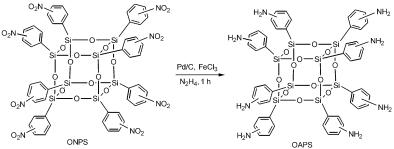1 Lickiss, P. D.; Rataboul, F. Adv. Organomet. Chem. 2008, 57, 1.  2 Cordes, D. B.; Lickiss, P. D.; Rataboul, F. Chem. Rev. 2010, 110, 2081. 2 Cordes, D. B.; Lickiss, P. D.; Rataboul, F. Chem. Rev. 2010, 110, 2081.  3 Du, J.-K.; Yang, R.-J. Fine Chem. 2005, 6, 409 (in Chinese). (杜建科, 杨荣杰, 精细化工, 2005, 6, 409.)4 Nagendiran, S.; Alagar, M.; Hamerton, I. Acta Mater. 2010, 58, 3345. 3 Du, J.-K.; Yang, R.-J. Fine Chem. 2005, 6, 409 (in Chinese). (杜建科, 杨荣杰, 精细化工, 2005, 6, 409.)4 Nagendiran, S.; Alagar, M.; Hamerton, I. Acta Mater. 2010, 58, 3345.  5 Iyer, P.; Coleman, M. R. J. Appl. Polym. Sci. 2008, 108, 2691. 5 Iyer, P.; Coleman, M. R. J. Appl. Polym. Sci. 2008, 108, 2691.  6 Choi, J.; Kim, S. G.; Laine, R. M. Macromolecules 2004, 37, 99. 6 Choi, J.; Kim, S. G.; Laine, R. M. Macromolecules 2004, 37, 99.  7 Asuncion, M. Z.; Laine, R. M. Macromolecules 2004, 40, 555.8 Liu, H. Z.; Zheng, S. X. Macromol. Rapid Commun. 2005, 26, 196. 7 Asuncion, M. Z.; Laine, R. M. Macromolecules 2004, 40, 555.8 Liu, H. Z.; Zheng, S. X. Macromol. Rapid Commun. 2005, 26, 196.  9 Guo, H. Q.; Meador, M. A. B.; Mccorkle, L.; Quade, D. J.; Guo, J.; Hamilton, B.; Cakmak, M.; Sprowl, G. ACS Appl. Mater. Interfaces 2011, 3, 546. 9 Guo, H. Q.; Meador, M. A. B.; Mccorkle, L.; Quade, D. J.; Guo, J.; Hamilton, B.; Cakmak, M.; Sprowl, G. ACS Appl. Mater. Interfaces 2011, 3, 546.  10 Cho, H. S.; Liang, K. W.; Chatterjee, S.; Pittman, C. U. J. Inorg. Organomet. Polym. 2006, 15, 541.11 Tamaki, R.; Tanaka, Y.; Asuncion, M. Z.; Choi, J.; Laine, R. M. J. Am. Chem. Soc. 2001, 123, 12416. 10 Cho, H. S.; Liang, K. W.; Chatterjee, S.; Pittman, C. U. J. Inorg. Organomet. Polym. 2006, 15, 541.11 Tamaki, R.; Tanaka, Y.; Asuncion, M. Z.; Choi, J.; Laine, R. M. J. Am. Chem. Soc. 2001, 123, 12416.  12 Ervithayasuporn, V.; Wang, X.; Gacal, B.; Gacal, B. N. J. Organomet. Chem. 2011, 696, 2193. 12 Ervithayasuporn, V.; Wang, X.; Gacal, B.; Gacal, B. N. J. Organomet. Chem. 2011, 696, 2193.  13 Du, J.-K. Ph.D. Dissertation, Beijing Institute of Technology, Beijing, 2006 (in Chinese). (杜建科, 博士论文, 北京理工大学, 北京, 2006.) 13 Du, J.-K. Ph.D. Dissertation, Beijing Institute of Technology, Beijing, 2006 (in Chinese). (杜建科, 博士论文, 北京理工大学, 北京, 2006.)  14 Zhang, J.; Xu, R. W.; Yu, D. S. J. Appl. Polym. Sci. 2007, 103, 1004. 14 Zhang, J.; Xu, R. W.; Yu, D. S. J. Appl. Polym. Sci. 2007, 103, 1004.  15 Ye, C.-C.; Yin, Z.-H.; Gao, H.-L.; Meng, W.; Sun, H. Z. Journal of Central South University of Forestry & Technology 2008, 28, 160 (in Chinese). (叶翠层, 殷作虎, 高海丽, 孟维, 孙汗洲, 中南林业科技 大学学报, 2008, 28, 160.)16 Fu, G.-Y; Zhang, G.-H; He, X.; Huang, B. New Chem. Mater. 2009, 3, 88 (in Chinese). (付桂云, 张国辉, 何旭, 黄斌, 化工新型材料, 2009, 3, 88.)17 Chen, M.-W.; Gan, L.-Z. J. East China Institute of Chemical Technology 1985, 11, 105 (in Chinese). (陈敏为, 甘礼骓, 华东化工学院学报, 1985, 11, 105.)18 Wiener, H.; Sasson, Y.; Blum, J. J. Mol. Catal. 1986, 35, 277. 15 Ye, C.-C.; Yin, Z.-H.; Gao, H.-L.; Meng, W.; Sun, H. Z. Journal of Central South University of Forestry & Technology 2008, 28, 160 (in Chinese). (叶翠层, 殷作虎, 高海丽, 孟维, 孙汗洲, 中南林业科技 大学学报, 2008, 28, 160.)16 Fu, G.-Y; Zhang, G.-H; He, X.; Huang, B. New Chem. Mater. 2009, 3, 88 (in Chinese). (付桂云, 张国辉, 何旭, 黄斌, 化工新型材料, 2009, 3, 88.)17 Chen, M.-W.; Gan, L.-Z. J. East China Institute of Chemical Technology 1985, 11, 105 (in Chinese). (陈敏为, 甘礼骓, 华东化工学院学报, 1985, 11, 105.)18 Wiener, H.; Sasson, Y.; Blum, J. J. Mol. Catal. 1986, 35, 277.  19 Larsen, J. W.; Freund, M.; Kim, K. Y.; Sidovar, M.; Stuart, J. L. Carbon 2000, 38, 655. 19 Larsen, J. W.; Freund, M.; Kim, K. Y.; Sidovar, M.; Stuart, J. L. Carbon 2000, 38, 655.  20 Zhao, B.; Han, W.-F.; Huo, C.; Liu, H.-Z. J. Zhejiang Univ. Technol. 2004, 32, 131 (in Chinese). (赵波, 韩文峰, 霍超, 刘化章, 浙江工业大学学报, 2004, 32, 131.)21 Chen, Y.-J. Chemical Reaction Engineering and Technology 2002, 18, 275 (in Chinese). (陈筱金, 化学反应工程与工艺, 2002, 18, 275.) 20 Zhao, B.; Han, W.-F.; Huo, C.; Liu, H.-Z. J. Zhejiang Univ. Technol. 2004, 32, 131 (in Chinese). (赵波, 韩文峰, 霍超, 刘化章, 浙江工业大学学报, 2004, 32, 131.)21 Chen, Y.-J. Chemical Reaction Engineering and Technology 2002, 18, 275 (in Chinese). (陈筱金, 化学反应工程与工艺, 2002, 18, 275.) |
